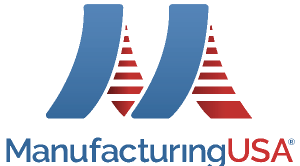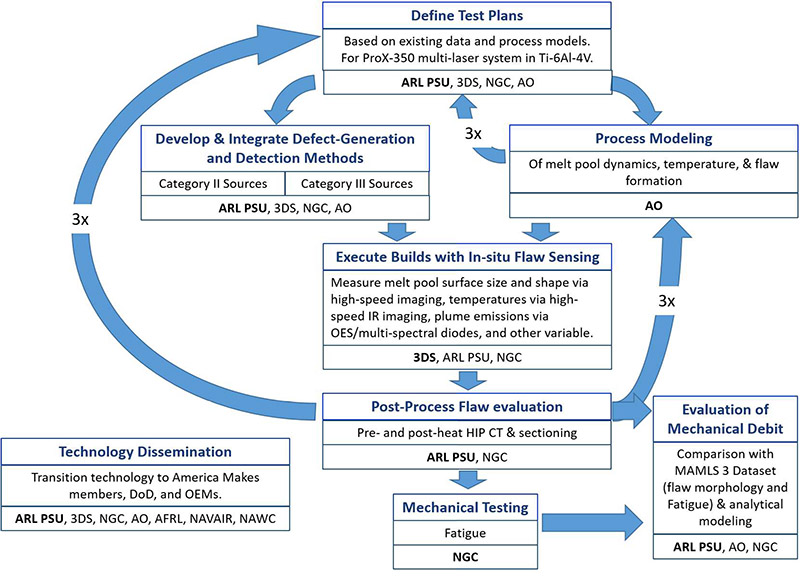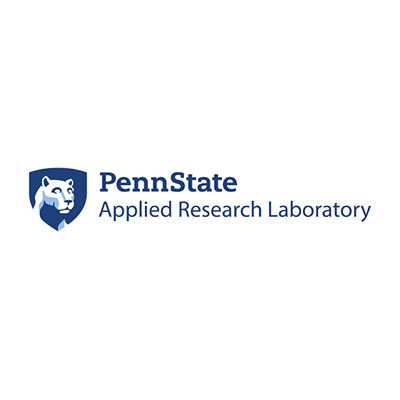


Project flowchart indicating tasks for project completion and assigned team members.
Problem
It is well established that flaws, such as lack-of-fusion or spherical porosity, occur during Powder Bed Fusion Additive Manufacturing (PBFAM). Depending on their morphology and location, flaws can negatively affect build and part quality. Equally problematic is the lack of guidelines establishing limits on the size, morphology, location of flaws, and verified strategies to estimate the mechanical property debits incurred due to the presence of flaws. The failure to establish accepted models or relationships between flaw characteristics and mechanical properties, to define nondestructive evaluation (NDE) guidelines, to quantify the reliability of sensing methods, and to implement rapid certification/ qualification strategies for PBFAM is partly due to the current, limited ability to reproduce flaws, representative of natural ones, in a controlled fashion.
Objective
The project team included The Pennsylvania State University Applied Research Laboratory (Penn State), 3D Systems, Applied Optimization, and Northrop Grumman. A test plan was developed to characterize controlled flaws in the PBFAM process. Process modeling of the experimental plan was performed by Applied Optimization. Penn State led the development of in-process anomaly generation methods and in-situ monitoring of flaw generation during sample builds. Test samples were printed using a 3D Systems ProX-320 machine with the developed in-situ monitoring capabilities added. The resultant test samples were then characterized, tested, and analyzed to establish an extensive dataset containing in-process sensor signatures, computed tomography (CT), and metallographic data for identified defect types and morphologies. Resultant hardware, software, and data were transitioned to America Makes and the Department of Defense (DoD) at the conclusion of the effort.
Technical Approach
The project team includes The Pennsylvania State University Advanced Research Laboratory (Penn State), 3D Systems, Applied Optimization, and Northrop Grumman. A test plan is being developed to characterize controlled flaws in the PBFAM process. Process modeling of the experimental plan is being performed by Applied Optimization. Penn State is leading the development of in-process anomaly generation methods and in-situ monitoring of flaw generation during sample builds. Test samples are being printed using a 3D Systems ProX-320 machine with the developed in-situ monitoring capabilities added. The resultant test samples are then characterized, tested, and analyzed to establish an extensive dataset containing in-process sensor signatures, computed tomography (CT), and metallographic data for identified defect types and morphologies. Resultant hardware, software, and data are being transitioned to America Makes and Department of Defense at the conclusion of the effort.
Accomplishments
Among the methods assessed, sporadic fluctuations of processing power most reliably generate lack-of-fusion and keyhole-induced porosity, representative of that observed in real parts. Analytical models are effective in predicting resulting flaw size and location using the input magnitude, number of layers, and area over which laser power fluctuations are set; though, data-driven models perform better. A key finding of this work was, even with a lack of fusion on the order of 0.8 mm in diameter, located on the order of 1 mm from a machined surface, post-process hot isostatic pressing resulted in high-cycle fatigue performance as good as wrought material. The results of this work are useful for the qualification of AM designs, processes, and components. The developed methods should be used in the generation of specific flaw morphologies (e.g. size, orientation, etc.) at intended locations. If adopted and further developed, the methods reported will enable researchers to systematically evaluate material performance as a function of defect characteristics. Moreover, these methods will enable reliable, model-based guidance on appropriate design limits for defect morphology and locations within components of interest to the aerospace and DoD communities.
Project Participants
Project Principal

Other Project Participants
- 3D Systems
- Applied Optimization
- Northrop Grumman
Public Participants
- U.S. Department of Defense
